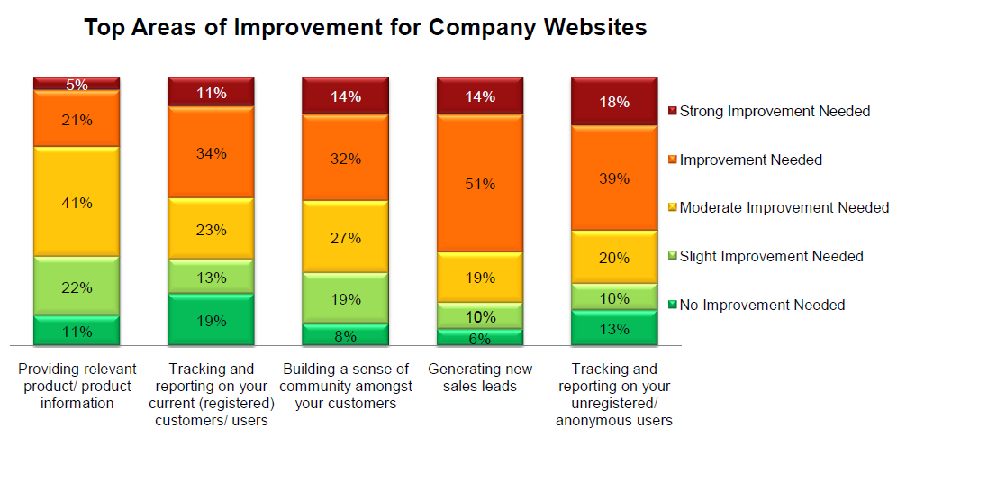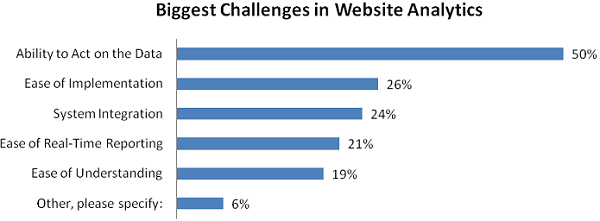In some respects, online selling has become easier than ever before. We have social media to attract customers and build awareness, blogs to demonstrate daily industry-specific expertness, and Web sites to capture leads and move visitors through the funnel we create. You would think that businesses have all the tools they need to convert at their disposal. And maybe they do, but that doesn’t mean they’re using them effectively.
According to a recent Demandbase survey of 100 B2B marketing & IT professionals, only 20 percent of respondents say their Web site is generating maximum lead generation potential. For the Math-dumb, that means a whopping 80 percent know their Web site could be doing better but either don’t know how to fix it or simply haven’t invested the energy into doing it.
This is a problem.
I spent some time reading through the Demandbase survey (after Frank Reed pointed me to it yesterday. Thanks, Frank!) and couldn’t help but think there were a lot of takeaways here for businesses of all sizes. If you’re looking for ways to turn your Web site into a lead generation magnet, below are some things to focus on.
Re-tailor the Web site experience.
This is something we’re seeing across the board. Even though we still may be trying to encourage small business owners to even develop a Web site, at the same time we’re encouraging everyone else to re-evaluate how they’re using theirs. Because user habits and buying behaviors have changed. To be effective, your Web site needs to evolve to reflect this.
I found it pretty interesting that despite “corporate website” being listed as the Top Lead Source under only Personal Connections & Referrals, B2Bs still aren’t optimizing their sites for the people they’re trying to attract. With Buying 2.0 behaviors in full force, customers are doing their due diligence researching products and services online before they ever contact you. That means you need to account for that when you build your Web site. You need to develop different landing pages to engage different types of customers who are landing on your site at different stages of the buying cycle. If that’s not something you’re doing now or if it seems a little confusing, I’d recommend you check out Vanessa Fox’s talk on user personas to see how she does it. I’ve read up on many different ways to tackle this, but I like her idea of tying personae to tasks as a way of offering relevant content earlier in the process.
We need to invest more in analytics.
While the majority of B2B marketers understand the importance of analytics and have implemented analytic programs on their Web sites, they’re still not using the data that’s being reported to improve performance or better convert visitors. They’re simply hoarding it and hoping it will keep them warm at night. As the chart below illustrates, tracking and reporting unregistered/anonymous users is among the top areas of improvement cited for B2B Web sites.

The survey also noted that 30 percent of respondents are ONLY using Google Analytics “a free Web Analytics tool”. They’re not using social media monitoring tools, site performance tools, paid analytics tools, etc, which speaks to the maturity (or lack thereof) in the industry. They’re putting all their eggs in one basket and then ignoring the basket exists in the first place. And we wonder why we’re not capitalizing off our Web sites as strongly as we could be.
…And that includes ACTING on analytics.
According to the report, one-half of all respondents cited the ability to act on their data as their biggest analytics challenge.

See, now that breaks my heart into a million tiny pieces. Because if you’re not going to ACT on the data you receive, you’re just wasting everyone’s time by collecting it. It’s like paying for a gym membership when you have no intention of walking through those doors because you’re too busy eating mac n cheese on your couch. And, of course, at the same time, I know that’s exactly what way too many businesses, B2B and B2C, are doing. If you’re serious about maximizing your Web site as a lead generation tool then investing in analytics becomes a no-brainer to help you understand what is happening on your site. Because even more horrifying than the idea that 50 percent of B2Bs can’t act on data is that 45 percent of them have no idea where their customers are most likely to abandon their Web sites.
[blinks]
Dude. Just open your analytics. It will be there staring you in the face.
As the study notes, by only focusing on where the visitor enters your site (be it the home page, or a specific landing page) rather than the pages they visit while they are there, or how long they spend on the site, marketers do not capture the data necessary to determine where the buyer is in the purchasing funnel. It’s time to understand how to use your analytics and turn the lights on. Because right now you’re walking into walls and ignoring customers who are trying to find you. Again commented in the survey is that better use of Web analytics tools will improve the performance of the corporate website, delivering key insight around content engagement and exit pages. There’s a reason Google’s now trying to charge you $150k/ a year for premium analytics.
The reason is that your site analytics are super important.
It’s your job to transform your Web site from stagnant brochure to your business’ lead generation tool. You do this by taking by using all the tools available to you to gain insight on your customer (social media, blogging, analytics, etc) and then using that data to find new opportunities to personalize their experience. What do customers want and how can you build upon that? The answers are there if you take the time to ask the right questions.

